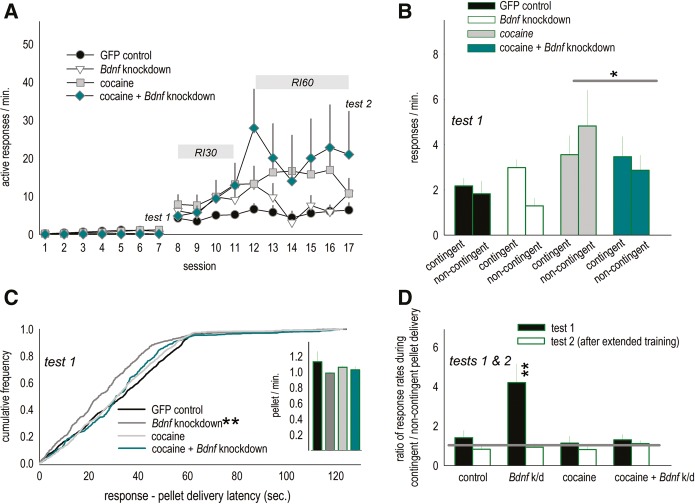Figure 3.
Adolescent cocaine exposure occludes Bdnf-mediated behavioral plasticity. (A) BALB/c mice were exposed to cocaine or saline prior to Bdnf knockdown. Mice were later trained to respond for food reinforcers, then the response–outcome contingencies were modified as above. After an initial test, mice were shifted from a continuous reinforcement schedule to random interval (RI) schedules of reinforcement as indicated. A second test is annotated as “test 2.” (B) Response rates during different pellet delivery conditions during the initial test are shown: A history of cocaine exposure nonspecifically increased response rates, regardless of whether pellet delivery was contingent or noncontingent upon responding. (C) When pellets were delivered noncontingently at a fixed rate, responses generated by knockdown mice were temporally more closely aligned with pellet delivery (as in Fig. 2E). Prior cocaine exposure blocked this effect. This was despite pellet delivery rates that did not differ between groups (inset). (D) Response ratios indicated that drug-naïve Bdnf knockdown mice were highly sensitive to response–outcome contingencies (black bars, as in Fig. 2D); however, a history of cocaine exposure entirely occluded the effect of targeted Bdnf knockdown, resulting in insensitivity to degradation of the instrumental contingency. With extended training, all mice ultimately developed habitual response strategies, as annotated by white bars and the gray line at 1. Thus, Bdnf knockdown in drug-naïve mice delays, but does not fully block, habit formation. Bars and symbols = means + SEMs, (*) P ≤ 0.05, (**) P ≤ 0.001 vs. all other groups. (k/d) Knockdown, (RI30) random interval 30 sec, (RI60) random interval 60 sec.

